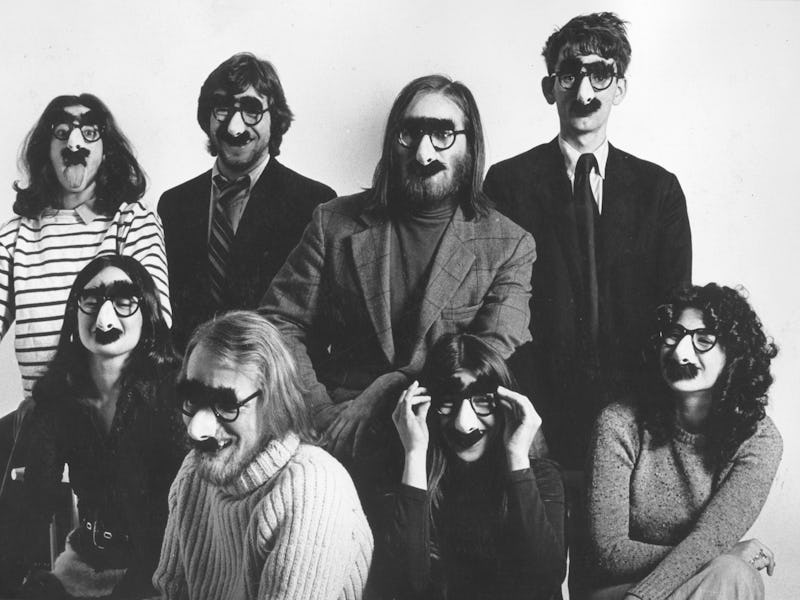The Anarchic Genius of 'National Lampoon'
The influential magazine's writers lived fat, drunk, and stupid. But it didn't last.

There will never be another magazine quite like the National Lampoon. Many have tried to copy its unrelenting, acerbic wit and its uncanny mix of high concepts with bare asses, but none has been able to match it. For every derivative outlet (Vice, The Onion) or any arch-lowbrow filmmakers it preceded (Judd Apatow), the National Lampoon exists as a singular example of making the mainstream as uncomfortable as possible.
This is the broad thesis statement of filmmaker Douglas Tirola’s new documentary Drunk Stoned Brilliant Dead: The Story of the National Lampoon. The doc traces the history of the infamous adult humor magazine from its beginnings as a nationwide spinoff of the Harvard Lampoon by founders Doug Kenney and Henry Beard, where it became the second-most popular magazine in America in the mid ‘70s, to glossing over its ignominious downward spiral to cancellation starting in the mid-‘80s. It now trudges on as a licensed brand name for mindlessly gross-out DVDs headed straight to the bottom of the dollar bin.
The doc itself is pure crowd-pleaser, mostly by animating the magazine’s most outrageous copy, to let the work speak for itself. But even though it provides a swath of former contributors, performers like Chevy Chase, and filmmakers like John Landis relaying a series of fabulous anecdotes, the film only manages to cover a cursory history of the shenanigans over its 98-minute runtime. Is it enough?
Compacting the wild, nearly 30-year history of the magazine is as complex as it is funny. From the founding of the magazine and branching off into different mediums like radio and TV before internal strife dissolved it in the face of talent poached by the likes of Hollywood and Saturday Night Live, there’s a lot covered in a short time. But it isn’t anything an interested party couldn’t figure out by falling down a Wikipedia hole starting with National Lampoon and ending up on the murderer’s row of comedy legends who handled the madness. Perhaps such a multi-faceted and intricate deep-dive of something that started as a print magazine conveniently works best in the same medium, like the similarly named but unrelated 2010 book Drunk Stoned Brilliant Dead: The Writers and Artists Who Made the National Lampoon Insanely Great.
The famous January 1973 cover.
Thankfully the doc centers its emotional nucleus around Kenney, a face unrecognizable to the general public but whose talent and humor informed every aspect of the Lampoon’s brand of humor. Portrayed as an eccentric hippie given to biting topical satire, he personified the magazine. It’s no surprise then that Kenney’s talent was as intense as his manic depression that stirred drama in the Lampoon’s ranks. In the offices that were churning out page after subversive page lambasting Nixon and white middle-class America, Kenney’s self-destructive personality finally caught up with him even as he saw his idea blossom into a pillar of modern American comedy.
Kenney typified the notion that counterculture creativity has a short half-life. Specifically, for Kenney and the early Lampoon staff, the heaps of money rolling in added pressure to what had been simply dicking around to make your friends laugh.
The fleeting influence of National Lampoon can be understood in broader terms as well. Like any publication that grabs an audience with sensationalism, National Lampoon transgressed the norms of a specific zeitgeist — in its case, the post-World War II, then-current Vietnam-era. The laughs could last only so long as the stagflation of the ‘70s turned into the Greed Generation ‘80s. The slackers lost. Kenney and the magazine were drained.
The editorial staff of the 'National Lampoon,' with co-founder Henry Beard at the top-center.
But this was the anarchic genius of the National Lampoon. None of its staffers ever really thought that far ahead, so they just treated it as if they were just a group of adults in arrested development trying to laugh as long as they could. Maybe this is why a cursory history like Drunk Stoned Brilliant Dead is the best way to tell the story. Why, for the love of Animal House would you over-intellectualize the National Lampoon?
As former Lampoon art director Michael Gross puts it in the film, people enjoyed the magazine because they told themselves, “These are a bunch of jerkoffs just like me.” There lies the tragedy of Kenney and the Lampoon. They were jerkoffs, but there’s no longevity in being a jerkoff. Making fun of Nixon, Vietnam, John Lennon, and the rest of the status quo worked for five years. Then, like Van Wilder, it began to get old. That amount of freedom with that little overhead could never last, and that makes the National Lampoon the last best place for a particular type of humor. Its influence still reverberates in outlets like Funny or Die, College Humor, and The Onion’s burgeoning goofball empire.
As the character Dean Wormer says in Animal House, the Lampoon’s first movie, “Fat drunk and stupid is no way to go through life.” Says him. For those prime years, the National Lampoon made it the absolute right way to live. It wouldn’t have been as funny any other way.